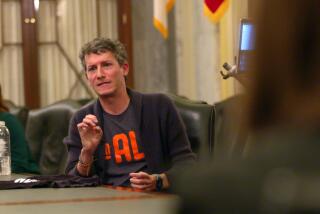Her Family Lost to AIDS, Survivor Begins to Cope
- Share via
CRESSON, Pa. — The photographs of her husband and son, always gaunt and almost always grim-faced, are everywhere: on walls, on tables, on the refrigerator.
For Lauren Burk, they are an aching reminder of how she lost both her hemophiliac husband and young son to AIDS and how she herself has AIDS-related symptoms. But they are also sources of solace.
“I don’t think I’d be able to face just shutting him out and not seeing him anymore. I want to see him,” Burk, 27, said, gazing at her husband’s framed photographs on a coffee table in her mobile home.
“I don’t want to remember him the last day because it was just constantly crying and him saying, ‘Don’t cry.’ Me saying, ‘I’m scared,’ and him saying, ‘Well, don’t be scared.’ ”
Patrick Burk, 29, died March 18 at home in bed, with Lauren’s arms around him.
He had contracted the deadly AIDS virus about four years earlier, apparently from his regular doses of blood-clotting concentrates, and unwittingly passed it on to his wife, who became pregnant with their son, Dwight.
The baby contracted the disease before birth, becoming the world’s first reported case of acquired immune deficiency syndrome in the child of a hemophiliac, according to the British medical journal, The Lancet.
Dwight died Dec. 13, 1985, two days past 20 months of age.
“It was harder when Patrick died,” Burk said softly, “even though I believe a big part of Patrick died when the baby died. The baby was his life and his pride and his joy.
“When Dwight died, there was somebody here. We were here for each other. When Patrick died, you go to bed and you cry and there’s just nobody to hold you or say it’s OK.”
There is 6-year-old Nicole, a healthy first-grader from Burk’s first marriage. She tenderly cares for her brother’s Cabbage Patch doll and the other toys still in his dresser drawers.
“She accepts it the way I do,” Burk said. “She says God had to make a choice and he left me down here to take care of her and he had to take Daddy up there to take care of Dwightie.”
Thinking that, believing that, still doesn’t ease the pain or stop the tears. Neither do the two classes Burk is taking this fall at a junior college or the companionship of her sister-in-law, who has moved in temporarily.
“I cry a lot. I do it at night when there’s nobody here. That’s the hardest time, at night,” said Burk, who has been diagnosed as having AIDS-related complex, an illness that does not necessarily lead to AIDS. Her symptoms include swollen lymph nodes, weight loss and exhaustion.
Still, she says she feels better now than in a long time and test results are encouraging.
More than anything, Burk, a registered nurse on disability, wants to take in a baby with AIDS.
She has contacted New York’s Weiler Hospital of the Albert Einstein College of Medicine about becoming a foster parent but has not yet been able to bring a child to Pennsylvania.
“I think it may help,” said her mother-in-law, Donna Burk. “At least we’d have somebody to try to help and do what we could, make (the baby) feel a little better.”
While she waits, Lauren Burk looks ahead.
“I feel like I’m going to do good for years,” she said. “But I also look at it from the viewpoint of, well, what if? What if I do get sick? What if I get full-blown AIDS?
“That’s why I live every day like it’s my last, because you just never know. I want to make sure I’ve done most of the things in my life that if I died tomorrow, I could say, ‘Well, you know, I did pretty much, and I’m pretty satisfied.’ ”
More than 24,000 people in the United States have died of AIDS, according to the U.S. Centers for Disease Control. Of them, 381 have been children and 249 hemophiliacs.
AIDS, which is spread through infected blood, blood products or other body fluids, mainly strikes homosexual men and intravenous drug abusers in this country.
Dwight is believed to be the only child of a hemophiliac born with AIDS who has died, said Dr. Peter Levine, former medical director of the National Hemophilia Foundation. Levine knows of only two other such cases, but both youngsters are alive.
Dwight’s plight, detailed in 1985 in The Lancet, prompted the foundation that year to advise the nation’s 20,000 hemophiliacs to postpone having children until more could be learned. The recommendation remains in effect.
“It focused attention on how important it was for us to develop intensive guidelines, intensive programs, for helping to keep this tragedy from repeating itself,” Levine said.
Eager to do what she can, Burk keeps abreast of AIDS research and occasionally contacts stricken families, like that of Clifford and Louise Ray, whose three hemophiliac, AIDS-exposed sons encountered resistance when they returned to school in August. Soon afterward, the family’s Arcadia, Fla., home burned down.
Burk says she has been fortunate in that respect.
Local people rallied behind her family and thousands of dollars poured into a trust fund, although that later landed in court because of differences over how the money should be spent.
Sponsors of the fund contended the money was collected for Dwight. The Burks countered that they should be free to use it for any medical-related expenses, including a Bahamas cruise they took after Dwight’s death on a psychiatrist’s advice.
A judge ruled in January that the Burks could keep 75% of the $15,000 left in the fund but could not use it to pay for the cruise. He ordered that the remaining 25% go to terminally ill children.
These days, Burk says, visitors regularly stop by to invite her out, but she seldom accepts, preferring to spend time alone with her daughter.
She is adjusting, she says, to this new, empty life and learning ever so slowly to accept her family’s fate.
“My only salvation is knowing that someday the four of us will all be together again,” said Burk, whose name and birth date are carved into the heart-shaped tombstone on her husband’s grave. “That’s how I cope with life, thinking we’ll be together again.”
More to Read
Sign up for Essential California
The most important California stories and recommendations in your inbox every morning.
You may occasionally receive promotional content from the Los Angeles Times.













